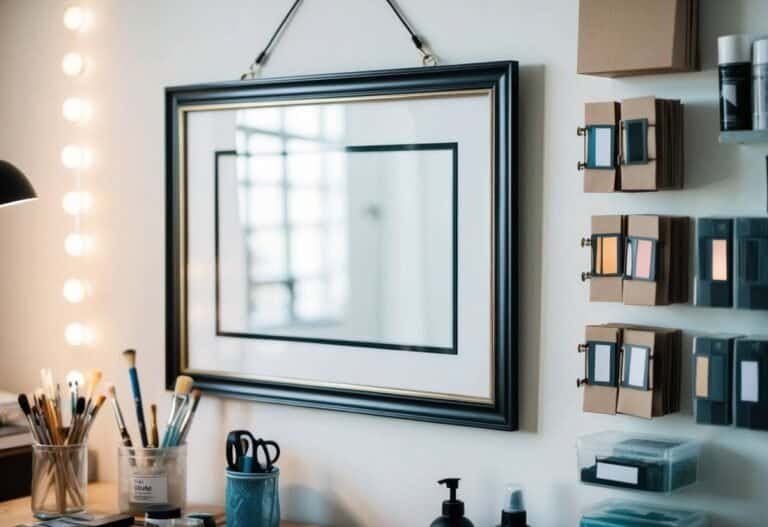Choosing the Right Glass for Your Art: Mastering UV Protection and Glare Reduction
Choosing the right glass for your art can make a big difference. The type of glass you use impacts how well your artwork is protected and how it looks.
Factors like UV protection and glare reduction are important to consider when selecting glass for framing.
Different types of glass offer varying levels of protection and clarity, impacting both preservation and viewing experience.
Artists and collectors often seek options that both safeguard their art and highlight its beauty.
Some glasses block harmful ultraviolet rays, while others minimize reflections.
The choice of glass can also depend on environmental factors where the artwork will be displayed, like humidity and light exposure.
Advanced technologies in glazing provide additional options to protect valuable pieces.
Key considerations extend beyond glass properties to include innovative solutions for long-term art preservation.
Key Takeaways
- Glass choice affects protection and display.
- Enhanced glazing offers more preservation.
- Environmental factors influence glass selection.
Understanding Framing Glass
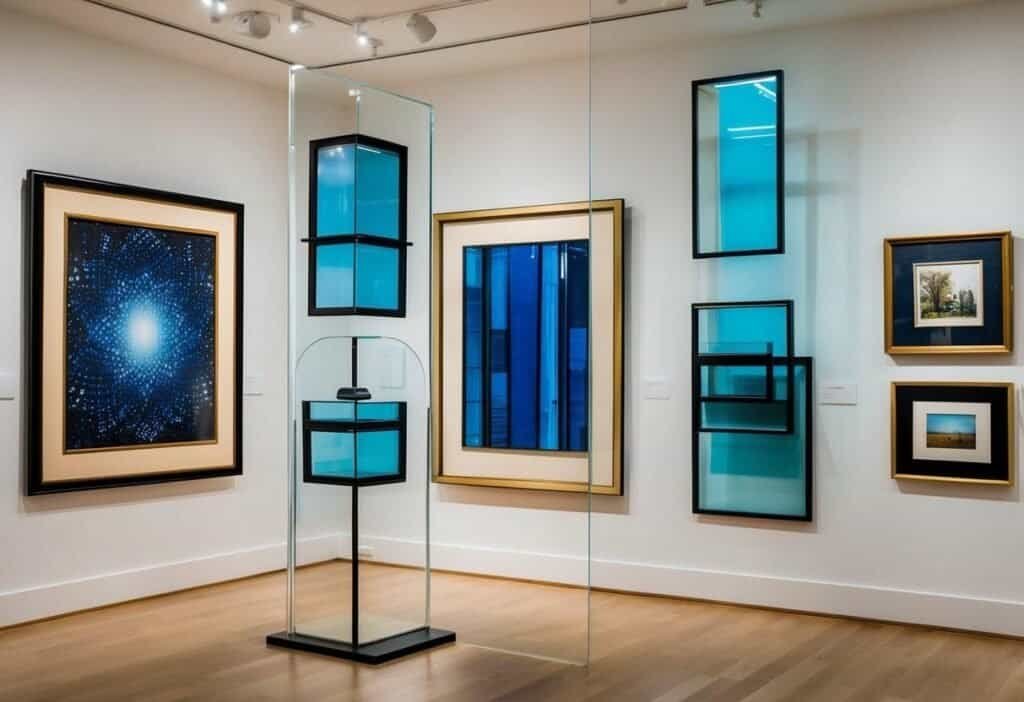
Framing glass serves many purposes like protecting art from damage and improving its display.
Key considerations include types of glass, differences between glass and acrylic, and various properties like UV protection and clarity.
Types of Glass
Framing glass comes in various types, each offering different benefits.
Clear glass is the most basic option, providing clarity but lacking any special features.
For better protection, UV filter glass helps block harmful ultraviolet rays, thus preserving artworks.
Museum glass offers both UV protection and anti-reflective qualities. It is ideal for high-value pieces, as it gives the best clarity and reduces glare significantly.
Non-glare glass has a special coating to limit reflections but might reduce image sharpness slightly.
Framers can choose the right type by considering their needs for visibility and protection.
Glass vs. Acrylic
Choosing between glass and acrylic depends on various factors.
Glass, especially anti-reflective glass, provides excellent clarity and better protection against scratches.
Acrylic or plexi glazing, on the other hand, is lighter and more resistant to shattering.
Acrylic’s shatter resistance makes it a good choice for safety in certain settings or when framing larger artworks.
Acrylic glazing can also be treated for UV protection and glare reduction, though it may scratch easier than glass.
This comparison guides framers on the right choice based on the setting and value of the art.
Analyzing Glass Properties
Several factors determine the suitability of framing glass for a particular piece.
Clarity and visibility are critical for showcasing the artwork without distortion.
Reflection control is another important property, as it influences how the display looks under different lighting conditions.
UV protection is crucial to prevent fading, especially for valuable or light-sensitive art.
Lastly, thickness can affect durability and impact resistance, offering additional protection against breakage.
All these properties help in deciding which glass type ensures both safety and appearance of the framed art.
Factors Affecting Artwork Protection
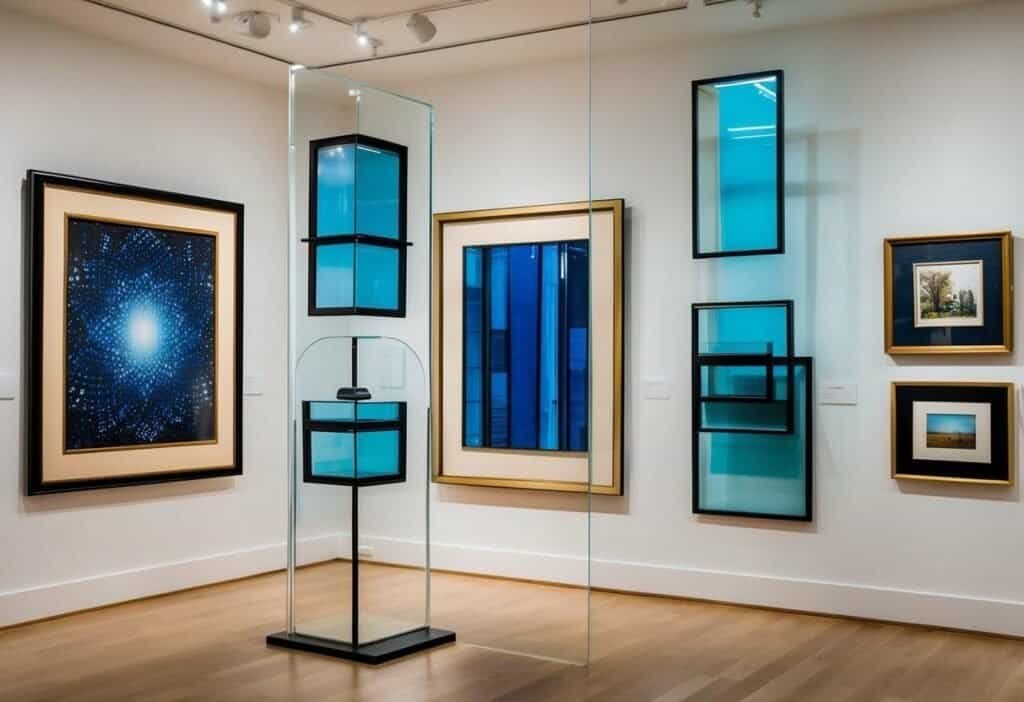
Protecting artwork involves choosing glass that offers UV protection and minimizes glare. The right glass can help safeguard against fading and deterioration from environmental factors, ensuring long-term preservation.
Role of UV Protection
UV rays can significantly damage artwork. Using UV-protective glass helps block harmful rays that cause fading.
Conservation glass is designed to filter out up to 99% of UV rays, making it ideal for preserving art that is frequently exposed to light.
UV filtering is essential for pieces that cannot be rotated or relocated often.
Selecting the right glass also depends on the artwork’s framing needs.
UV-protective glass glazing can be a vital addition to frames, ensuring that art remains vibrant and protected over time. Investing in good protection now can save on restoration costs later.
Preventing Fading and Deterioration
Fading occurs when colors lose their intensity due to light exposure.
Glass glazing with UV protection can slow this process.
Deterioration can also result from exposure to heat and humidity. Choosing glass with these factors in mind can reduce risks.
Environmental factors like temperature changes can also affect art, making protective glass important for long-term preservation.
It’s crucial for collectors and artists alike to think about both current display conditions and potential future changes when selecting glass.
Glare Reduction and Reflection Control
Glare can obscure details in artwork, affecting the viewing experience.
Non-glare glass is designed to minimize reflections. It helps viewers see colors and details without distraction.
Reflection control glass reduces both direct and ambient light reflections, offering a clearer view.
Choosing glass with glare reduction qualities is essential for displaying art in well-lit areas.
It’s beneficial for both private collections and public galleries aiming for optimal viewing conditions. Non-glare glass can often pair with UV filtering, offering dual benefits for artwork protection.
Comparing Glazing Options
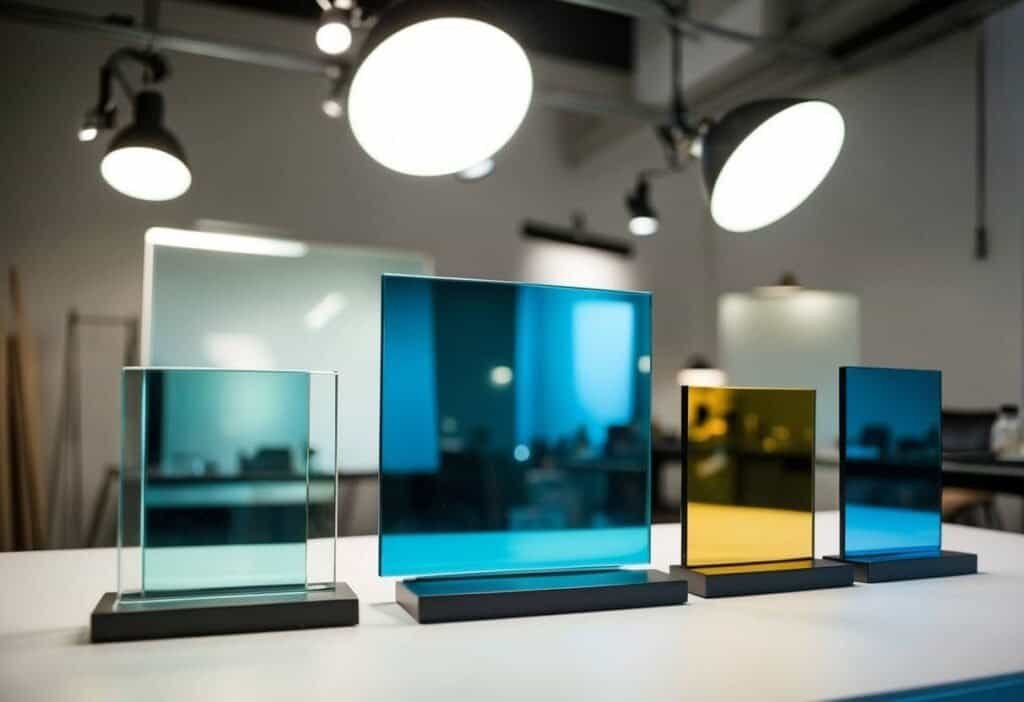
Choosing the right glass for art is crucial to ensure the artwork’s longevity and visibility. Different glazing options provide various benefits like UV protection and glare reduction.
Standard vs. Conservation Glazing
Standard glass is a common and affordable option for framing art. It provides a clear view without any special protective features.
Standard glass, sometimes referred to as premium clear glass, works well for pieces that aren’t exposed to direct sunlight or valuable items that don’t require preservation.
Conservation glazing, on the other hand, offers advanced UV protection to prevent color fading and preserve the artwork’s original condition.
It often includes conservation clear and conservation reflection control glass. This type of glass is ideal for valuable or irreplaceable artwork.
While more expensive, conservation glazing is an investment in the artwork’s future.
Specialty Glazing Solutions
Specialty glazing solutions address unique concerns artists and art owners might have.
Conservation reflection control glass is designed to limit glare without sacrificing image clarity. This is beneficial for artworks displayed in brightly lit areas or under spotlights.
Other options might include anti-static coatings and anti-scratch features.
These provide further protection by reducing dust buildup and scratches, keeping the piece looking its best over time.
In addition, specialty glazings like museum glass combine several protective features for maximum art preservation and display quality.
While typically higher in cost, these glazing solutions are tailored to specific needs, ensuring the best protection and display for various art pieces.
The Impact of Physical Factors
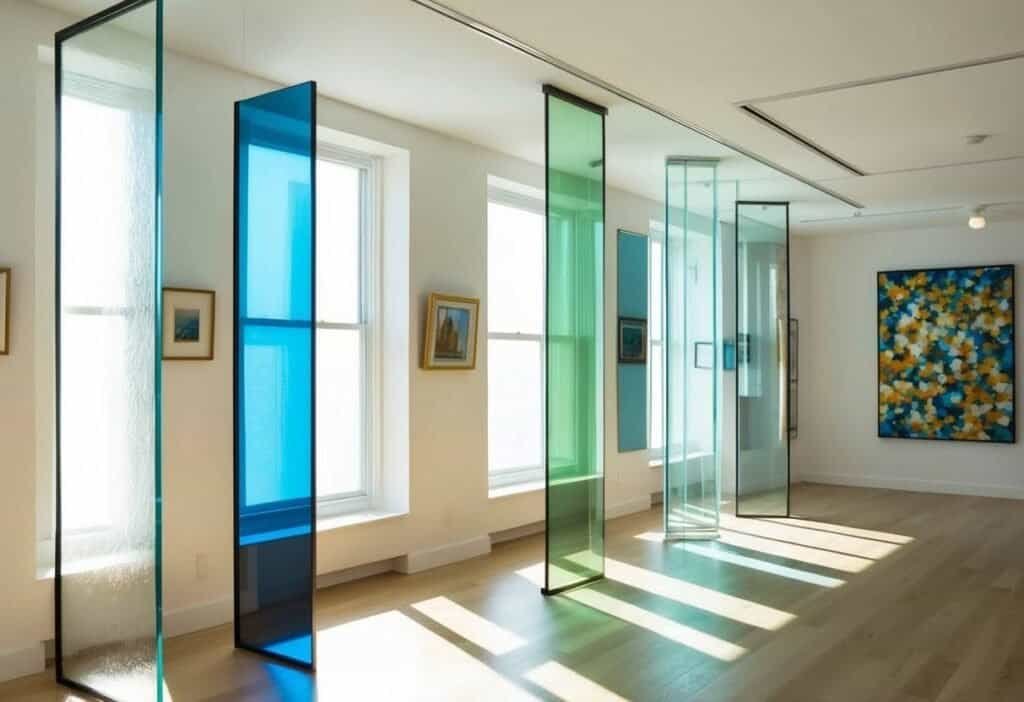
Choosing the right glass for art involves understanding thickness, strength, and shatter resistance. These factors directly impact the durability and safety of glass used in picture frames and displays. Selecting the most suitable attributes ensures protection for artwork.
Importance of Thickness and Strength
Framing glass comes in various thicknesses, typically ranging from 2 mm to 5 mm.
Thicker glass provides added strength, offering better protection against accidental knocks and environmental stress.
This added strength can be crucial in high-traffic areas or public spaces where art displays might be vulnerable.
Thinner glass can be lighter and easier to handle, making it suitable for smaller frames. However, it may lack the durability needed for larger pieces.
Multiplying thickness often results in increased weight, which should be considered when planning to hang or move the artwork.
Art professionals often weigh the need for strength against the weight, ensuring that the choice of glass can support the artwork while maintaining its visual appeal.
Laminated or tempered glass options provide greater robustness without excessive bulk, providing an ideal balance for most framing needs.
Considering Shatter Resistance
Shatter-resistant glass is crucial for safety, especially in environments with children or pets.
Laminated glass features a layer of plastic between sheets, which holds the glass together if broken, minimizing shards.
Tempered glass undergoes a treatment process, making it stronger and more resilient to impacts.
When it breaks, it crumbles into small, less dangerous pieces. This feature significantly reduces the risk of injury compared to standard glass.
For large picture frames, using shatter-resistant options can prevent potential accidents, especially in public galleries or schools.
Ensuring the glass is safe yet functional allows art to be enjoyed without compromising viewer safety. By prioritizing shatter resistance, one protects both the artwork and the people who interact with it.
Choosing the Right Glass for Specific Artwork

Selecting the appropriate glass for artwork ensures its protection and enhances its display. Factors like glare reduction, UV protection, and type of artwork influence this choice.
Glass choice often depends on the work’s value and the environment where it’s displayed.
For Limited Edition Prints and Original Works
Limited edition prints and original works require careful consideration to maintain their value and appearance.
UV protection is vital, as sunlight can fade colors and damage the materials over time.
Art glass with a high rating for UV filtering is recommended. This will shield the pieces from harmful rays.
Glare reduction is another factor to consider. Reducing glare helps in enhancing the viewing experience by minimizing reflections.
Museum glass or non-reflective glass options might be preferable. They offer clarity and decrease glare, ensuring art can be viewed without distractions.
When customizing frames, consider using anti-static glazing to prevent dust from settling on the art, especially important for limited edition or delicate works.
Consult a professional framer who can provide advice on custom framing solutions to effectively protect and display the artwork.
For Photographs and Certificates
Photographs and certificates have different needs.
Photographs, especially those with sentimental or historic value, benefit from anti-glare glass to ensure that details stay sharp and visible.
Using UV-protective glass will help prevent color fading over time, important for keeping photos vibrant.
Certificates might not always require UV protection, but ensuring clarity and anti-glare properties will keep text readable and well-preserved.
In both cases, prevent direct sunlight exposure and opt for glass that complements the viewing environment.
Introduce mats or spacers when framing photographs. They provide air circulation and avoid sticking to the glass. For certificates, lighter frames with clear glass or acrylic can provide an elegant presentation without compromising protection.
Advanced Glazing Technologies

When choosing glass for artwork, understanding advanced glazing options can make a significant difference. These technologies help protect art from UV rays and reduce glare while enhancing clarity and vibrancy.
Key advancements include Optium Museum Acrylic and anti-reflective coatings that cater to the needs of artists and collectors alike.
Optium Museum Acrylic and More
Optium Museum Acrylic combines the best in UV protection and clarity for artwork. It offers up to 99% UV protection, ensuring artworks do not fade or discolor. This acrylic is lightweight, making it easier to handle and less prone to breakage compared to regular glass.
In addition, Optium Acrylic is scratch-resistant, which helps maintain its look over time. This material is ideal for high-value and delicate pieces.
When choosing Optium, consider factors like the size and value of the art and how it will be displayed. Lightweight and clear, it is a smart choice for galleries and museums seeking advanced protection.
Anti-Reflective Coatings
Anti-reflective coatings are applied to glass to minimize glare and enhance visibility. These coatings work by reducing light reflection, allowing artwork to be viewed without the distracting shine of typical glass surfaces.
The result is a clearer, more vibrant presentation of colors and details.
Technologies used in anti-reflective glass often incorporate multiple layers of coating, significantly cutting down on reflection. This makes them perfect for spaces with bright lighting.
When selecting anti-reflective glass, consider how the piece will be lit. Such glass ensures that each viewer has a clear, uninterrupted view, preserving the integrity of the displayed artwork.
Considerations Beyond the Glass
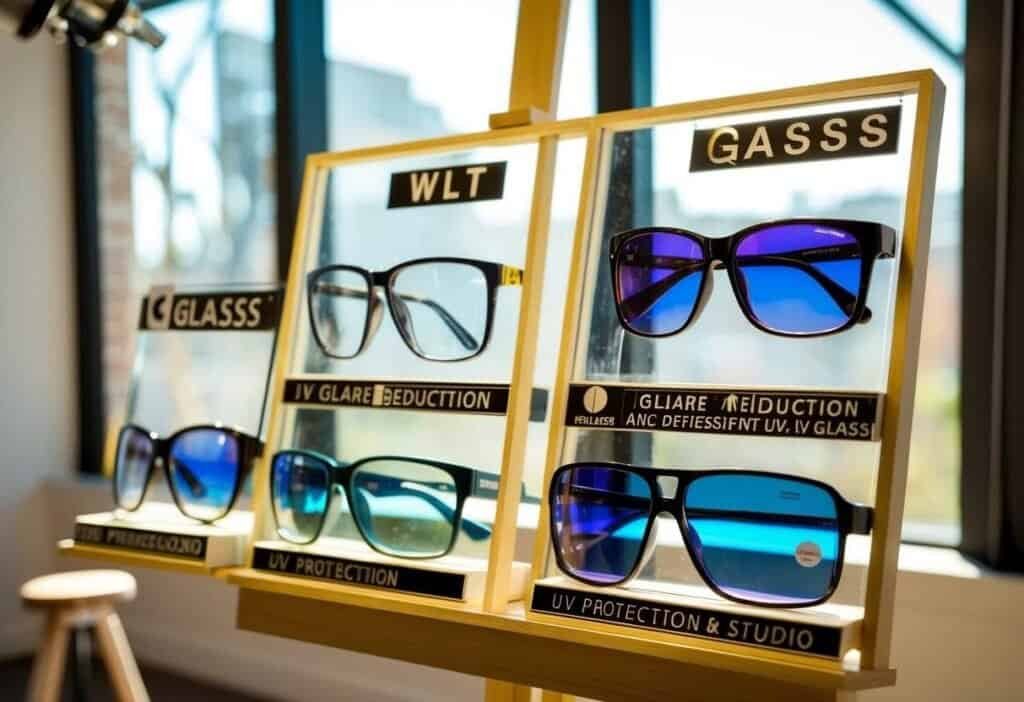
When choosing the right glass for art, it’s important to think about external factors that can affect the display. Environmental challenges and placement in the room play a big role in preserving art.
Environmental Challenges
Environmental factors can significantly impact artwork longevity. Humidity and temperature are critical aspects to consider.
High humidity may cause warping or mold, while extreme temperature changes can lead to cracking. To protect art, it’s beneficial to maintain a stable climate where the art is housed. Using a dehumidifier or air conditioner can help.
Pollutants like dust, smoke, and even chemicals in cleaning products can damage artwork over time. It is wise to use air purifiers to minimize these threats.
Additionally, regular cleaning with artist-safe products ensures pollutants don’t accumulate on the surface.
Diffuse light is often preferred over direct light, which can cause fading. Curtains or shades that filter UV rays may be helpful.
This helps in adjusting lighting conditions to shield art from harmful rays that could otherwise degrade color and texture.
Display and Placement
The display environment is crucial for both aesthetic and protective reasons. Placement of art should consider both visual appeal and safety.
Avoid spots near windows or direct sunlight to reduce exposure to harmful UV rays, which can fade art. Placing art on a wall without exposure to direct sunlight is ideal.
Lighting conditions also need attention. Using LED lights, which emit minimal heat and UV radiation, is a smart choice.
Installing art lights that allow for controlled illumination can enhance visual appeal without compromising safety.
Thinking about placement involves ensuring art is out of reach from accidental bumps or spills. Choosing secure hanging systems adds an extra layer of protection, especially in high-traffic areas, to prevent accidental falls or damage.
Innovative Solutions for Art Preservation

In art conservation, using new materials helps ensure the longevity of artworks while addressing challenges like weight and static charge.
Lightweight and Durable Materials
Art protection often demands materials that are both lightweight and strong. Acrylic and polycarbonate sheets are excellent options.
They are lighter than glass, making them easier and safer to handle. These materials also provide high impact resistance, reducing the risk of damage during handling or display.
Another innovation is using laminated glass. This consists of multiple layers and offers increased strength. When broken, it holds together, preventing shards from scattering.
This characteristic makes laminated glass a safer alternative, while its clarity and surface quality make it a favorable choice for art displays.
UV-blocking films are also essential. These films can be applied to the surface of acrylic or glass, providing additional protection against harmful ultraviolet rays.
By filtering out UV light, these films help prevent the fading and degradation of art over time.
Managing Static Charge
Static charge can attract dust and particles, which may damage fragile surfaces.
Managing static is crucial for preserving art.
Anti-static coatings on display cases can significantly reduce this risk. These coatings work by dissipating static electricity, preventing dust from clinging to surfaces.
Static-dissipative plastics are another solution.
These materials have built-in properties that minimize static build-up. This is especially useful for artworks made of materials sensitive to dust, such as paper or textiles.
Humidifiers also play a role in managing static.
Proper humidity levels in display areas can reduce static electricity.
Maintaining humidity between 40-50% is optimal for minimizing static without causing other harm to the artworks.






